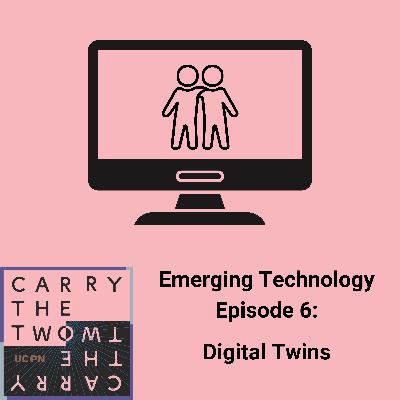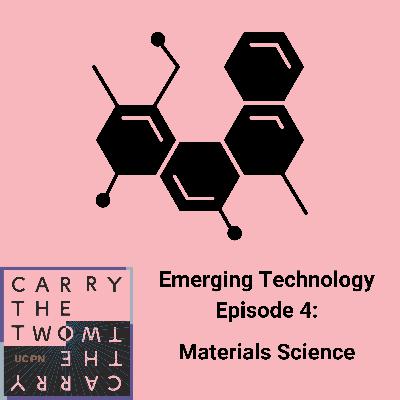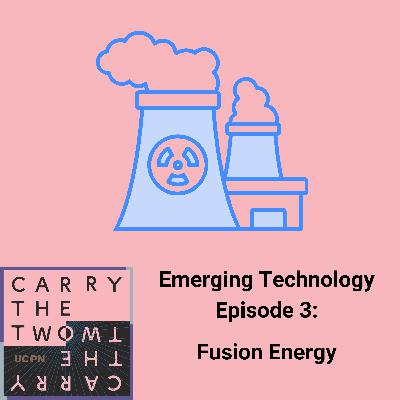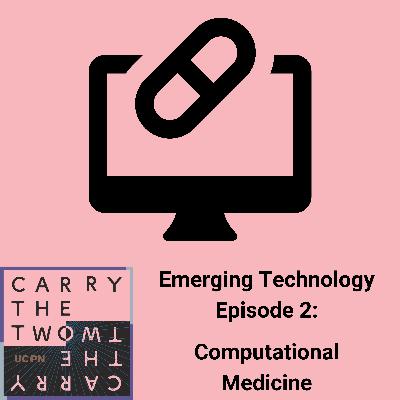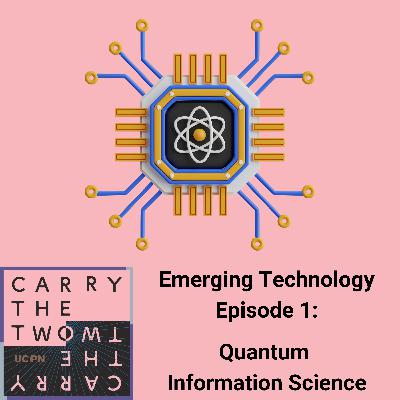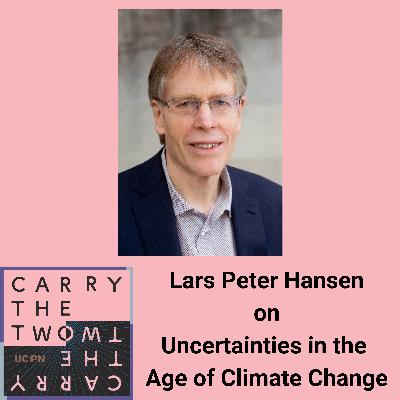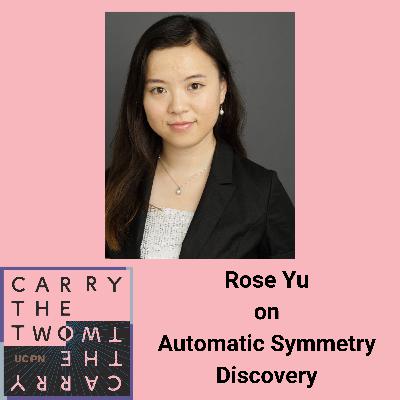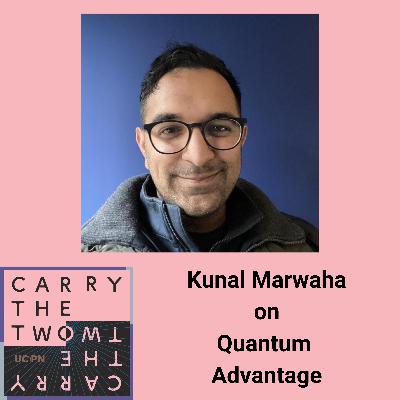Discover Carry the Two
Carry the Two

Carry the Two
Author: IMSI
Subscribed: 87Played: 2,105Subscribe
Share
© 2022 IMSI
Description
Carry the Two pulls back the curtain to reveal the mathematical and statistical gears that turn the world. We’re the show for people who enjoy discovering hidden elements that impact our lives in the most unexpected ways, and math is certainly one of those!
We are a curiosity-driven podcast that looks to find unique perspectives from the fields of mathematics and statistics.
We use stories to convey how mathematical research drives the world around us, with each episode tackling a different topic. This can be anything from modeling how bees in a swarm make group decisions to how we can use textual analysis to reveal surprising changes in policy documents.
You can also find Carry the Two on Apple Podcasts, Stitcher, Google Play, and Spotify.
Carry the Two is hosted by Sadie Witkowski and Ian Martin. Audio production by Tyler Damme. Music is from Blue Dot Sessions.
We are a curiosity-driven podcast that looks to find unique perspectives from the fields of mathematics and statistics.
We use stories to convey how mathematical research drives the world around us, with each episode tackling a different topic. This can be anything from modeling how bees in a swarm make group decisions to how we can use textual analysis to reveal surprising changes in policy documents.
You can also find Carry the Two on Apple Podcasts, Stitcher, Google Play, and Spotify.
Carry the Two is hosted by Sadie Witkowski and Ian Martin. Audio production by Tyler Damme. Music is from Blue Dot Sessions.
55 Episodes
Reverse
Welcome to Carry the Two, the podcast about how math and statistics impact the world around us from the Institute for Mathematical and Statistical Innovation. In this season of Carry the Two we are going to be examining how math and stats is helping scientists, engineers, and industry develop new and emerging technologies. This episode is all about Digital Twins. Hosts Sam Hansen and Sadie Witkowski are joined by Karen Willcox professor of aerospace engineering and engineering mechanics at the University of Texas at Austin, Director of the Oden Institute for Computational Engineering and Sciences, and external faculty member at the Santa Fe Institute and Anna Michalak founding Director of the Climate and Resilience Hub at the Carnegie Institution for Science and professor at the Stanford-Doerr School of Sustainability.
Find our transcript here: Google Doc or .txt file
Curious to learn more? Check out these additional links:
Toward predictive digital twins: From physics-based modeling to scientific machine learning
Application of Digital Twins to Large-Scale Complex Systems
Digital Twins Long Program
Foundational Research Gaps and Future Directions for Digital Twins
Digital twins in mechanical and aerospace engineering
Follow more of IMSI’s work: www.IMSI.institute, (bluesky) IMSI.institute (instagram) IMSI.institute
Music by Blue Dot Sessions
The Institute for Mathematical and Statistical Innovation (IMSI) is funded by NSF grant DMS-1929348
Welcome to Carry the Two, the podcast about how math and statistics impact the world around us from the Institute for Mathematical and Statistical Innovation. In this season of Carry the Two we are going to be examining how math and stats is helping scientists, engineers, and industry develop new and emerging technologies. This episode is all about Computation Imaging. Hosts Sam Hansen and Sadie Witkowski are joined by Rebecca Willett the Worah Family Professor of Statistics and Computer Science in the Wallman Society of Fellows at the University of Chicago, Stanley Chan Elmore Professor of Electrical and Computer Engineering and Statistics Purdue University, and David Lindell Assistant Professor at the University of Toronto in the Department of Computer Science.
Find our transcript here: Google Doc or .txt file
Curious to learn more? Check out these additional links:
Panel Discussion: Computational Imaging: Who cares?
Wavefront Estimation: How to Prescribe Glasses for your Telescope?
Imaging Anytime Anywhere: Capturing Dynamic Scenes from Seconds to Picoseconds
Follow more of IMSI’s work: www.IMSI.institute, (bluesky) IMSI.institute (instagram) IMSI.institute
Music by Blue Dot Sessions
The Institute for Mathematical and Statistical Innovation (IMSI) is funded by NSF grant DMS-1929348
Welcome to Carry the Two, the podcast about how math and statistics impact the world around us from the Institute for Mathematical and Statistical Innovation. In this season of Carry the Two we are going to be examining how math and stats is helping scientists, engineers, and industry develop new and emerging technologies. Our first episode is all about Computation Medicine. Hosts Sam Hansen and Sadie Witkowski are joined by Danny Perez, a staff scientist at Los Alamos National Lab in New Mexico, Logan Ward, a PhD computational scientist, and Jason Hattrick-Simpers, a professor of material science and engineering at the University of Toronto and a research scientist at Natural Resources Canada, CMAT Materials.
Find our transcript here: Google Doc or .txt file
Curious to learn more? Check out these additional links:
Diverse data generation for machine learning potentials
The Importance of Publishing Everything, and How MDF Can Help
Understanding and Mitigating Bias in Autonomous Materials Characterization and Discovery
Follow more of IMSI’s work: www.IMSI.institute, (bluesky) IMSI.institute (instagram) IMSI.institute
Music by Blue Dot Sessions
The Institute for Mathematical and Statistical Innovation (IMSI) is funded by NSF grant DMS-1929348
Welcome to Carry the Two, the podcast about how math and statistics impact the world around us from the Institute for Mathematical and Statistical Innovation. In this season of Carry the Two we are going to be examining how math and stats is helping scientists, engineers, and industry develop new and emerging technologies. Our third episode is all about Fusion Energy. Hosts Sam Hansen and Sadie Witkowski are joined by Andrew Christlieb, Professor of mathematics and computational science and engineering at Michigan State University and director for the Center of Hierarchical and Robust Modeling for Non-Equilibrium Transport, and Cristina Rea, principal research scientist here at the Plasma Science and Fusion Center at the Massachusetts Institute of Technology and leader of the Disruption Studies Group.
Find our transcript here: Google Doc or .txt file
Curious to learn more? Check out these additional links:
Open and FAIR Fusion for Machine Learning Applications
Predicting fusion ignition at the National Ignition Facility with physics-informed deep learning
Follow more of IMSI’s work: www.IMSI.institute, (bluesky) IMSI.institute (instagram) IMSI.institute
Music by Blue Dot Sessions
The Institute for Mathematical and Statistical Innovation (IMSI) is funded by NSF grant DMS-1929348
Welcome to Carry the Two, the podcast about how math and statistics impact the world around us from the Institute for Mathematical and Statistical Innovation. In this season of Carry the Two we are going to be examining how math and stats is helping scientists, engineers, and industry develop new and emerging technologies. Our first episode is all about Computation Medicine. Hosts Sam Hansen and Sadie Witkowski are joined by Yixiang Deng assistant professor at the University of Delaware in Department of Computer and Information Sciences and Fides Schwartz a radiologist at the Brigham and Women's Hospital focusing on CT, computer tomography, imaging.
Find our transcript here: Google Doc or .txt file
Curious to learn more? Check out these additional links:
Exploring the Frontiers of Computational Medicine
Photon-counting CT yields superior abdominopelvic image quality at lower radiation and iodinated contrast doses
Follow more of IMSI’s work: www.IMSI.institute, (bluesky) IMSI.institute (instagram) IMSI.institute
Music by Blue Dot Sessions
The Institute for Mathematical and Statistical Innovation (IMSI) is funded by NSF grant DMS-1929348
Welcome to Carry the Two, the podcast about how math and statistics impact the world around us from the Institute for Mathematical and Statistical Innovation. In this season of Carry the Two we are going to be examining how math and stats is helping scientists, engineers, and industry develop new and emerging technologies. Our first episode is all about Quantum Computing and Information Science. Hosts Sam Hansen and Sadie Witkowski are joined by Ben Brown, researcher at IBM Quantum, and Yihui Quek, postdoc at MIT and incoming assistant professor at EPFL, Ecole Polytechnic Federal in Lausanne, for a discussion about quantum error correction and mitigation, as well as Dylan Temples, a Lederman Postdoctoral Fellow at Fermi National Accelerator Lab, who works at the intersection of dark matter direct detection and quantum information science.
Find our transcript here: Google Doc or .txt file
Curious to learn more? Check out these additional links:
Mitigating errors in logical qubits
Surviving as a quantum computer in a noisy world
Design directions in qubit-based dark matter sensors
Follow more of IMSI’s work: www.IMSI.institute, (twitter) @IMSI_institute, (mastodon) https://sciencemastodon.com/@IMSI, (instagram) IMSI.institute
Music by Blue Dot Sessions
The Institute for Mathematical and Statistical Innovation (IMSI) is funded by NSF grant DMS-1929348
We in the United States are deep in the middle of a major national election, and over half of the world’s population also have elections in 2024. This is why Carry the Two is going to focus on the intersection of mathematics and democracy for our new season.
In this, the sixth and final episode of our mathematics and democracy season, we dig into both how surveys and polls are conducted and how they are reported. For the former we are joined by David Dutwin Senior Vice President at NORC and Chief Scientist of Amerispeak and for the latter by Nathaniel Rakich Senior Editor and Senior Elections Analyst at FiveThirtyEight.
Find our transcript here: Google Doc or .txt file
Curious to learn more? Check out these additional links:
David Dutwin
NORC
AmeriSpeak
VoteCast
Nathaniel Rakich
FiveThirtyEight
Follow more of IMSI’s work: www.IMSI.institute, (twitter) @IMSI_institute, (mastodon) https://sciencemastodon.com/@IMSI, (instagram) IMSI.institute
Music by Blue Dot Sessions
The Institute for Mathematical and Statistical Innovation (IMSI) is funded by NSF grant DMS-1929348
We in the United States are deep in the middle of a major national election, and over half of the world’s population also have elections in 2024. This is why Carry the Two is going to focus on the intersection of mathematics and democracy for our new season.
In this episode, the fifth episode of our mathematics and democracy season, we dig into political numbers and statistics. Helping Sam and Sadie do the digging is Professor Sir David Spiegelhalter, FRS, OBE, emeritus professor of statistics at the University of Cambridge, former Professor for the Public Understanding of Risk at the University of Cambridge, past Chair of the Winton Centre for Risk and Evidence Communication, and current non-executive Director at the UK Statistics Authority. David discusses why it is so important to be a trustworthy communicator, the watchdog work the UK’s Office of Statistics Regulation is engaging in, and his personal manifesto for those who share political numbers and statistics.
Find our transcript here: Google Doc or .txt file
Curious to learn more? Check out these additional links:
David Spiegelhalter
UK Statistics Authority
Art of Statistics
Art of Uncertainty
Follow more of IMSI’s work: www.IMSI.institute, (twitter) @IMSI_institute, (mastodon) https://sciencemastodon.com/@IMSI, (instagram) IMSI.institute
Music by Blue Dot Sessions
The Institute for Mathematical and Statistical Innovation (IMSI) is funded by NSF grant DMS-1929348
In this episode, the fourth episode of our mathematics and democracy season, we dig into two stories about the intersection of political geography and mathematics. The first story comes from Ranthony Clark and is about her work with the Metric Geometry and Gerrymandering Group around identifying communities of interest, with a focus on her in Ohio alongside CAIR Ohio, the Ohio Organizing Collaborative (OOC), the Ohio Citizens Redistricting Commission, and the Kirwan Institute for the Study of Race and Ethnicity at Ohio State. The second story is about polling sites in cities, and the places in those cities that may not be covered as well as they should be. We hear from Mason Porter and Jiajie (Jerry) Luo, two members of the team, about how they used topological data analysis to find these holes in coverage.
Find our transcript here: Google Doc or .txt file
Curious to learn more? Check out these additional links:
Ranthony Clark
Collaborators for the data science team: Erin Chambers, Ranthony A. Clark, Moon Duchin, Parker Edwards, JN Matthews, Anthony Pizzimenti, Chanel Richardson, Parker Rule, and Ari Stern
Communities of Interest Paper
MGGG
Districtr
Mason Porter
Jiajie (Jerry) Luo
Persistent Homology for Resource Coverage: A Case Study of Access to Polling Sites
Authors: Abigail Hickok, Benjamin Jarman, Michael Johnson, Jiajie Luo, Mason A. Porter
Follow more of IMSI’s work: www.IMSI.institute, (twitter) @IMSI_institute, (mastodon) https://sciencemastodon.com/@IMSI, (instagram) IMSI.institute
Music by Blue Dot Sessions
The Institute for Mathematical and Statistical Innovation (IMSI) is funded by NSF grant DMS-1929348
We in the United States are deep in the middle of a major national election, and over half of the world’s population also have elections in 2024. This is why Carry the Two is going to focus on the intersection of mathematics and democracy for our new season.
In this, the third episode of our mathematics and democracy season, we speak to Andrea Mock, Gunnar Carlsson, Samin Aref, and Zachary Neal. We dig into what mathematics has to say about the stability of political coalitions, how mediators can make coalitions more stable, the ways in which Democrats and Republicans can be clustered together in the House of Representatives based on their votes, and the hidden third coalition of really successful legislators in the House that co-sponsorship data can illuminate.
Find our transcript here: Google Doc or .txt file
Curious to learn more? Check out these additional links:
Political structures and the topology of simplicial complexes
Andrea Mock & Ismar Volić
Gunnar Carlsson
The topology of politics: voting connectivity in the US House of Representatives
Pek Yee Lum, Alan Lehmann, Gurjeet Singh, Tigran Ishkhanov, Gunnar Carlsson, & Mikael Vejdemo-Johansson
Samin Aref
Zachary Neal
Identifying hidden coalitions in the US House of Representatives by optimally partitioning signed networks based on generalized balance
Samin Aref & Zachary Neal
Follow more of IMSI’s work: www.IMSI.institute, (twitter) @IMSI_institute, (mastodon) https://sciencemastodon.com/@IMSI, (instagram) IMSI.institute
Music by Blue Dot Sessions
The Institute for Mathematical and Statistical Innovation (IMSI) is funded by NSF grant DMS-1929348
We in the United States are deep in the middle of a major national election, and over half of the world’s population also have elections in 2024. This is why Carry the Two is going to focus on the intersection of mathematics and democracy for our new season.
In this episode, the second episode of our mathematics and democracy season, we speak again with mathematician Ismar Volić of Wellesley College and Director of the Institute for Mathematics and Democracy and Theodore R. Johnson, a scholar of Black electoral politics, a military veteran, and a contributing columnist at The Washington Post. We dig into what mathematics has to say about how the USA apportions members of the House of Representatives to states, learn how a fight between Jefferson and Hamilton over rounding led to the first presidential veto, and discuss different techniques for reforming the Electoral College.
Find our transcript here: Google Doc or .txt file
Curious to learn more? Check out these additional links:
Ismar Volić
Making Democracy Count: How Mathematics Improves Voting, Electoral Maps, and Representation
Institute for Mathematics and Democracy
Theodore R. Johnson
A Failing Grade for the Electoral College
Follow more of IMSI’s work: www.IMSI.institute, (twitter) @IMSI_institute, (mastodon) https://sciencemastodon.com/@IMSI, (instagram) IMSI.institute
Music by Blue Dot Sessions
The Institute for Mathematical and Statistical Innovation (IMSI) is funded by NSF grant DMS-1929348
IMSI is very proud to announce that Carry the Two is back and with a new co-host, IMSI’s new Director of Communications and Engagement Sam Hansen!
We in the United States are deep in the middle of a major national election, and over half of the world’s population also have elections in 2024. This is why Carry the Two is going to focus on the intersection of mathematics and democracy for our new season.
In this episode, the first episode of our mathematics and democracy season, we speak with mathematician Ismar Volić of Wellesley College and Director of the Institute for Mathematics and Democracy and Victoria Mooers, an economics PhD student at Columbia University. We discuss what mathematics has to say about our current plurality voting system, how switching to preference ranking votings systems could limit polarization and negative campaigning, and why too much delegation causes problems for those pushing for Liquid Democracy.
Find our transcript here: Google Doc or .txt file
Curious to learn more? Check out these additional links:
Ismar Volić
Making Democracy Count: How Mathematics Improves Voting, Electoral Maps, and Representation
Institute for Mathematics and Democracy
Victoria Mooers
Liquid Democracy. Two Experiments on Delegation in Voting
Follow more of IMSI’s work: www.IMSI.institute, (twitter) @IMSI_institute, (mastodon) https://sciencemastodon.com/@IMSI, (instagram) IMSI.institute
Music by Blue Dot Sessions
The Institute for Mathematical and Statistical Innovation (IMSI) is funded by NSF grant DMS-1929348
Welcome to Carry the Two, the podcast about how math and statistics impact the world around us from the Institute for Mathematical and Statistical Innovation. While we’re in between our more in-depth seasons, we like to bring you something a little different in mini-season format. And for this mini season, we are going to highlight some of the amazing researchers who have presented at IMSI over the past year. Our sixth, and final, guest is Lars Peter Hansen. Lars is the 2013 recipient of the Nobel Memorial Prize in Economics and a Professor at the University of Chicago with appointments at the Economics Department, the Booth School of Business, as well as the Statistics Department.. Lars joined us at IMSI for a workshop on Economic Impacts of Climate Change where he presented a talk titled: How should Climate Change Uncertainty Impact Social Valuation and Policy? Host Sam Hansen joined Lars for a conversation about the research in his talk and Lars’s time at IMSI.
Find our transcript here: Google Doc or .txt file
Curious to learn more? Check out these additional links:
Lars Peter Hansen
Article: How should Climate Change Uncertainty Impact Social Valuation and Policy
Follow more of IMSI’s work: www.IMSI.institute, (Bluesky) @imsi.institute, (twitter) @IMSI_institute, (instagram) IMSI.institute
Music by Blue Dot Sessions
The Institute for Mathematical and Statistical Innovation (IMSI) is funded by NSF grant DMS-1929348
Welcome to Carry the Two, the podcast about how math and statistics impact the world around us from the Institute for Mathematical and Statistical Innovation. While we’re in between our more in-depth seasons, we like to bring you something a little different in mini-season format. And for this mini season, we are going to highlight some of the amazing researchers who have presented at IMSI over the past year. Our fifth guest is Rose Yu. Rose is an associate professor in the computer science department of UC San Diego, and is also affiliated with the Halıcıoğlu Data Science Institute. Rose joined us at IMSI for a workshop on Learning Collective Variables and Coarse Grained Models where she presented a talk titled Automatic Symmetry Discovery from Data. Host Sam Hansen joined Rose for a conversation about the research in her talk and Rose’s time at IMSI.
Find our transcript here: Google Doc or .txt file
Curious to learn more? Check out these additional links:
Rose Yu
IMSI Talk: Automatic Symmetry Discovery from Data
Follow more of IMSI’s work: www.IMSI.institute, (Bluesky) @imsi.institute, (twitter) @IMSI_institute, (instagram) IMSI.institute
Music by Blue Dot Sessions
The Institute for Mathematical and Statistical Innovation (IMSI) is funded by NSF grant DMS-1929348
Welcome to Carry the Two, the podcast about how math and statistics impact the world around us from the Institute for Mathematical and Statistical Innovation. While we’re in between our more in-depth seasons, we like to bring you something a little different in mini-season format. And for this mini season, we are going to highlight some of the amazing researchers who have presented at IMSI over the past year. Our fourth guest isKunal Marwaha, a PhD student at the University of Chicago studying quantum computing. Kunal joined us at IMSI for a workshop on The Power of Near-Term Quantum Experiments where he presented a talk titled On the promise of quantum advantage for classical optimization. So, without further ado let’s get into my conversation with Kunal Marwaha. Host Sam Hansen joined Kunal for a conversation about the research in his talk and Kunal’s time at IMSI.
Find our transcript here: Google Doc or .txt file
Curious to learn more? Check out these additional links:
Kunal Marwaha
IMSI Talk: On the promise of quantum advantage for classical optimization
Follow more of IMSI’s work: www.IMSI.institute, (Bluesky) @imsi.institute, (twitter) @IMSI_institute, (instagram) IMSI.institute
Music by Blue Dot Sessions
The Institute for Mathematical and Statistical Innovation (IMSI) is funded by NSF grant DMS-1929348
Welcome to Carry the Two, the podcast about how math and statistics impact the world around us from the Institute for Mathematical and Statistical Innovation. While we’re in between our more in-depth seasons, we like to bring you something a little different in mini-season format. And for this mini season, we are going to highlight some of the amazing researchers who have presented at IMSI over the past year. Our third guest is Frank Wolak, a professor in the Department of Economics at Stanford University who teaches courses in energy and environmental economics and has been involved in the electricity industry and power systems for 25 years.. Frank joined us at IMSI for a workshop on The Architecture of Green Energy Systems: The Underlying Problem and Its Challenges where he presented a talk titled The Engineering Economics of Low Carbon Electricity Market Design. Host Sam Hansen joined Frank for a talk about the research in his talk and Frank’s time at IMSI.
Find our transcript here: Google Doc or .txt file
Curious to learn more? Check out these additional links:
Frank Wolak
IMSI Talk: The Engineering Economics of Low Carbon Electricity Market Design
Energy Market Game
Follow more of IMSI’s work: www.IMSI.institute, (twitter) @IMSI_institute, (mastodon) https://sciencemastodon.com/@IMSI, (instagram) IMSI.institute
Music by Blue Dot Sessions
The Institute for Mathematical and Statistical Innovation (IMSI) is funded by NSF grant DMS-1929348
Welcome to Carry the Two, the podcast about how math and statistics impact the world around us from the Institute for Mathematical and Statistical Innovation. While we’re in between our more in-depth seasons, we like to bring you something a little different in mini-season format. And for this mini season, we are going to highlight some of the amazing researchers who have presented at IMSI over the past year. Our second guest is Maria Chan,a scientist at Argonnne National Laboratory working at the Center for Nanoscale Materials who focuses on computational research involving materials in chemistry using a combination of physics, artificial intelligence and machine learning. Maria joined us at IMSI for a workshop on Machine Learning in Electronic Structure Theory where she presented a talk titled Theory-informed AI/ML for Microscopy & Spectroscopy. Host Sam Hansen joined Maria for a talk about the research in her talk and Maria’s time at IMSI.
Find our transcript here: Google Doc or .txt file
Curious to learn more? Check out these additional links:
Maria Chan
IMSI Talk: Theory-informed AI/ML for Microscopy & Spectroscopy
Follow more of IMSI’s work: www.IMSI.institute, (twitter) @IMSI_institute, (mastodon) https://sciencemastodon.com/@IMSI, (instagram) IMSI.institute
Music by Blue Dot Sessions
The Institute for Mathematical and Statistical Innovation (IMSI) is funded by NSF grant DMS-1929348
Welcome to Carry the Two, the podcast about how math and statistics impact the world around us from the Institute for Mathematical and Statistical Innovation. While we’re in between our more in-depth seasons, we like to bring you something a little different in mini-season format. And for this mini season, we are going to highlight some of the amazing researchers who have presented at IMSI over the past year. Our first guest is Thibaut Mastrolia, an assistant professor at the Industrial Engineering and Operation Research Department at UC Berkeley Thibaut joined us at IMSI for a workshop on Decision Making and Uncertainty where he presented a talk titled Recent advances in auction markets design and regulation policies. Host Sam Hansen joined Thibaut for a talk about the research in this talk and how Thibaut’s time at IMSI has helped move it forward.
Find our transcript here: Google Doc or .txt file
Curious to learn more? Check out these additional links:
Thibaut Mastrolia
IMSI Talk: Recent advances in auction markets design and regulation policies
Follow more of IMSI’s work: www.IMSI.institute, (twitter) @IMSI_institute, (mastodon) https://sciencemastodon.com/@IMSI, (instagram) IMSI.institute
Music by Blue Dot Sessions
The Institute for Mathematical and Statistical Innovation (IMSI) is funded by NSF grant DMS-1929348
Find our transcript here: LINK
Follow more of IMSI’s work: www.IMSI.institute, (twitter) @IMSI_institute, (mastodon) https://sciencemastodon.com/@IMSI, (instagram) IMSI.institute
Follow Sadie Witkowski: https://www.sadiewit.com/, @SadieWit
This episode was audio engineered by Tyler Damme.
Music by Blue Dot Sessions.
The Institute for Mathematical and Statistical Innovation (IMSI) is funded by NSF grant DMS-1929348.
In this classic episode, we explore how GPT-3, a free online natural language processing artificial intelligence by Open AI, does and doesn’t work. Make sure to stick around until the end for an update on how AI is a core demand between the Writers Guild of America and the Alliance of Motion Picture and Television Producers.
GPT-3 takes advantage of a whole new method of artificial intelligence research, called neural nets, to create plays, write code, and even roleplay as a historical figure. But what are the limitations to this kind of AI? University of Chicago professor Allyson Ettinger walks us through how GPT-3 manages to sound so human and where and how it fails in interesting ways.
Find our transcript here: LINK
Curious to learn more? Check out these additional links:
When GPT-3 accidentally lies: https://www.technologyreview.com/2022/11/18/1063487/meta-large-language-model-ai-only-survived-three-days-gpt-3-science/
Microsoft’s chatbot that went racist: https://www.theverge.com/2016/3/24/11297050/tay-microsoft-chatbot-racist
Is GPT-3 a replacement or tool for journalists: https://contently.net/2022/12/15/trends/chatgpt/
Entertainment Community Fund: https://entertainmentcommunity.org/
Science and Entertainment Exchange: http://scienceandentertainmentexchange.org/
AO3 and data scraping: https://www.transformativeworks.org/ai-and-data-scraping-on-the-archive/
Follow more of IMSI’s work: www.IMSI.institute, (twitter) @IMSI_institute, (mastodon) https://sciencemastodon.com/@IMSI, (instagram) IMSI.institute
Follow Caitlin Parrish: @caitcrime
Follow Allyson Ettinger: https://allenai.org/team, @AllysonEttinger
This episode was audio engineered by Tyler Damme.
Music by Blue Dot Sessions.
The Institute for Mathematical and Statistical Innovation (IMSI) is funded by NSF grant DMS-1929348.





